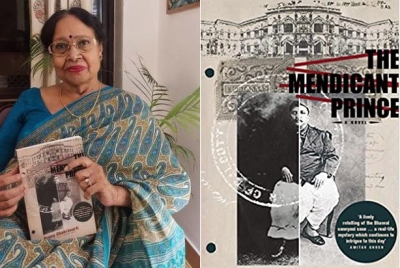By Vishnu MakhijaniNew Delhi, Sep 23 : A hundred and fifty years ago, Bhawal was a prosperous zamindari in the eastern part of undivided Bengal, in size and income next only to that owned by the Khwajas, the nawab family of Dacca.
In the winter of 1909, Ramendranarayan Roy, the ailing second prince of the Bhawal, travelled to Darjeeling with his wife Bibhavati, brother-in-law Satyendranath and a retinue of officials and servants, after his physicians advised a change of air.Three weeks later, a telegram from Satyendranath arrived at the Bhawal estate with news of the prince’s demise and his cremation.
But that was not the end of the matter, because 12 years later, the story took a bewildering turn with the arrival in Bhawal of a mendicant who claimed to be the long-lost prince and the heir to the estate.
After a protracted legal battle that went right up to the Privy Council, in what was known as the Bhawal sannyasi case, the mendicant was accepted as who he claimed to be – the heir to the estate.
This is a saga that has captivated renowned academic and Sahitya Akademy Award winner Aruna Chakravarti – she was the long-serving Principal of Delhi University’s Janki Devi College, where she taught for 40 years.After meticulous research, she has dramatically brought alive this intriguing tale of dual identity and the inexplicable quirks of fate in “The Mendicant Prince” (Picador India), her 16th novel.
“I first heard of the Bhawal case at the age of ten.But even at that tender age it left a powerful impact on me.I was captivated by the intricacies and unanswered questions.But I never thought of writing about it till recently, when some friends distantly related to the Bhawal family, urged me to,” Chakravarti told IANS in an interview.
Given that she had written two fictional family histories, on her own family in “The Inheritors” and the Tagore family in “Jorasanko” and “Daughters of Jorasanko”, she was “lured by the idea but resisted it at first.”
“It was too big and complex a project.The facts of the case were out in the public domain.
What more could I add to them? A fictional representation would not be easy.A meticulous adherence to the facts together with the dates was imperative.
A creative reconstruction of the case as well as the lives and times of the concerned persons called for tremendous imaginative power and an equal amount of discipline and concentration.I thought I wouldn’t be able to pull it off,” Chakravarti explained.
Then, during the Covid years, “when the whole world went into hibernation and there was nothing else to do, nowhere to go” she started working on it.
“Covid worked in my favour.In the complete silence and the total absence of activity, I found myself getting entrenched in the slowly unravelling world of queens and mistresses, liaisons and stratagems, suspense and mystery that constituted the background of the Bhawal story,” said.
But, while Covid gave her the space and silence to organise her thoughts, it was Covid again that put hurdles in the way of research.
“For all my other novels I have made it a point to do an extensive amount of field work.This time, travel being rendered impossible, I had to depend entirely on secondary sources.
Books and periodicals, both English and Bengali, provided the basic facts.Articles in Bangladeshi newspapers, of which there were a significant number, helped me to understand and visualise the context in which the drama had unfolded.
Through these readings, the sights, sounds and smells of feudal Bengal in the twilight years of the British Empire started slowly taking hold of my senses,” Chakravarti elaborated.
Two films, “Sannyasi Raja” and “Ek Je Chhilo Raja”, offered a few glimmerings but these, however, were negligible.
“What came in truly useful was the first-hand research I had done for my earlier work such as my translations of the Bengali masters and my own creative work.For example, my translations of Sunil Gangopadhyay’s ‘Sei Samay’ (Those Days) and ‘Prothom Alo’ (First Light) helped me obtain brilliant insights into the lives of rajas and zamindars of the era, their decadence and dwindling influence under the rising power of the British.
“The Mendicant Prince”, however, showcases a somewhat later period when British imperialism was slowly eroding under the pressure of an awakening nationalism.
Chakravarti also had the privilege of conversing with some relatives and family friends of the Bhawals.
“They were not structured interviews.Some family gossip and reminiscences were shared from time to time.
The identity question and quirks of fate were embedded in the history of the case.All I did was attempt to bring them to life by weaving, in between the facts, personal revelations of the characters, especially the women of the family.That part is purely fictional,” Chakravarti said.
Playing the Devil’s Advocate, is there a parallel between Ramendranarayan Roy and Gumnami Baba?
“The only parallel that can be drawn between the two is that both had been ascetics.Ramendranarayan claimed that after the incident of his supposed death, he had lost his memory and joined a band of mendicants.After twelve years of living as a sadhu he had remembered that he came from a place called Dhaka.Advised by his guru to go to Dhaka he had done so and, once there, the recovery of his memory was swift.”
“He realised that he was the second prince of the realm and demanded his rights as heir by moving the courts.His plea that he had suffered from amnesia in the intervening period had been put to the test by several doctors during the trial and was upheld by them and subsequently by the judge.”
“Gumnami Baba’s case was different.He didn’t claim loss of memory or identity.He said he had no name and no fixed place of residence.
Thus, his true identity remains unconfirmed to this day.The consequence of his rigid commitment to remain incognito was that very few people had actually seen him in person.Which is why he was considered by some to be Subhas Chandra Bose,” Chakravarti elaborated.
The book concludes with the funeral of Ramendranarayan Roy.What became of the Bhawal pargana after that?
“The Privy Council verdict came in July 1946.The Partition of India look place a year later in August 1947 and Bhawal became part of (East) Pakistan (Now Bangladesh).
Ramnarayan Roy, the adopted son of Anandakumari Debi (the wife of Ramendranarayan’s younger brother Rabindranarayan), succeeded briefly to his share of the zamindari.When the zamindari system was abolished in 1950, he moved to Kolkata.
He visited the estate from time to time but these visits seem to have stopped after 1960.As part of the settlement of Ramendranarayan’s share, a sum of Rs.eight lakh, was offered to Bibhavati.But she refused to take it.”
“The Rajbari (zamindar’s mansion) houses several government establishments.It has also become a tourist spot and visitors are taken on guided tours of parts of the palace and its grounds.”
Chakravarti has had a distinguished career as an academic, an administrator and as a writer.She has received the Sahitya Akademi Award, the Vaitalik Award and the Sarat Puraskar.
She has been shortlisted for the Commonwealth Writers Prize for her first novel, “The Inheritors”, while another novel, “Suralakshmi Villa”, has received the distinction of being designated “Novel of the Year (India 2020)” by the Journal of Commonwealth Literature.How did she manage to strike a seamless balance between the two careers?
“Looking back, I think one complimented the other.Administrative work was fulfilling at one level.Dry and uninspiring at another.
I felt I was doing some good to society by improving the lives and minds of my students through practical measures like raising funds for extracurricular activities, inviting good speakers to inspire them, procuring more books for the library, and bettering academic standards by choosing the best teachers.The job also provided the bread and butter.But I needed something more.I needed creative satisfaction.And that came from my writing.”
“I worked at my office desk all day looking forward to the evening when I could go back home and write.I wrote till late into the night and got up the next morning refreshed and ready to take on my administrative responsibilities.Balancing the two worked well for me,” Chakravarti explained.
Her next book, “Through a Looking Glass: Stories”, published by Om International, has just come out.It is a collection of nine stories, each with an enigmatic woman at the centre.
“The volume holds up a mirror to middle class Indian society by exploring the hidden, secret spaces of women’s lives; the inner recesses of their minds, and their perception of loss and suffering.There are studies of strength and weakness, triumph and defeat, unfulfilled desires, illicit liaisons, psychological traumas and family secrets – in one explosive mix,” Chakravarti concluded.
Such is what brilliance is all about!
(Vishnu Makhijani can be reached at [email protected])
vm/kvd
#Aruna #Chakravartis #Mendicant #Prince #dramatically #recreates #Delhi #Sunil #Kumari #Lakshmi # Lakshmi #Ali #Delhi #New Delhi #Una #Idea #Telegram #Covid
.






